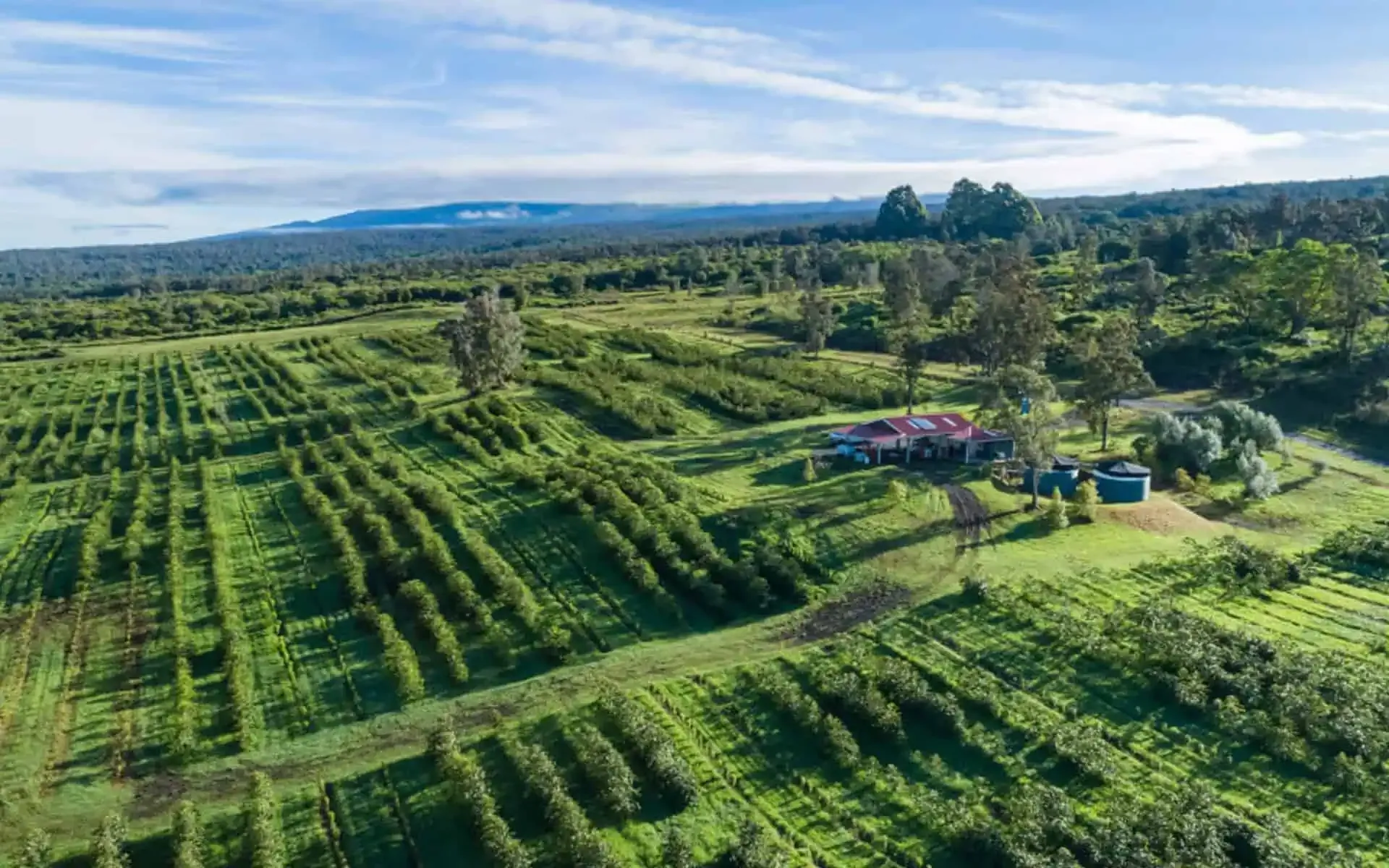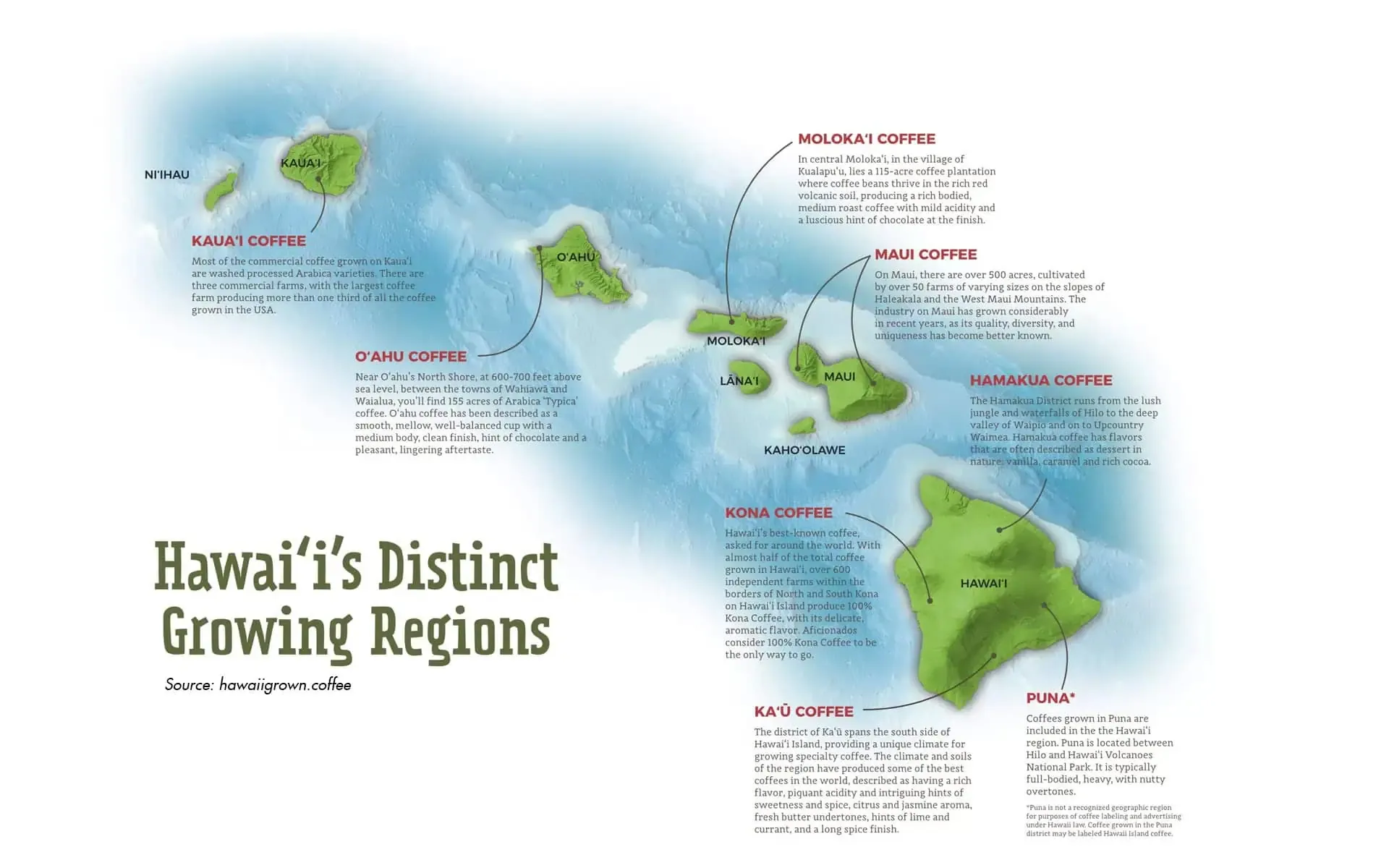Hawaii is renowned not only for its stunning beaches and majestic volcanoes but also as a coffee paradise with diverse growing regions, each offering unique flavors. Among these, the Kona region on the Big Island is hailed as the “holy land” of Hawaiian coffee, where you can embark on fascinating Kona coffee farm tours.
If you are a coffee lover and want to delve deeper into the production process of this special beverage, don’t miss the opportunity to explore Kona coffee farms. Here, you will immerse yourself in the lush greenery of coffee hills, learn about the history and culture of Kona coffee, and, of course, savor cups of delicious, high-quality coffee.
Discovering the “Kingdom of Coffee” – Kona
The Kona region, located on the west side of the Big Island of Hawaii, proudly stands as the most famous coffee-producing area in the archipelago. With approximately 900 farms stretching across 30 miles, Kona is a true “kingdom of coffee.” Kona coffee is grown on the slopes of the Mauna Loa and Hualalai volcanoes, at altitudes ranging from 500 to 3,000 feet (150 to 900 meters).
The natural conditions here are ideal for coffee plants to thrive: mineral-rich volcanic soil, a mild climate with an average temperature of around 70°F (21°C), moderate rainfall, and abundant sunshine. All these factors contribute to the distinctive flavor of Kona coffee, unlike any other coffee in the world.

Experiencing Kona Coffee Farm Tours
One of the most unique travel experiences in Kona is taking a tour of the coffee farms. Most farms here are small-scale, ranging from 2 to 5 acres, and are managed by families with long-standing coffee-growing traditions.
During a farm tour, you will:
- Learn about the coffee growing and care process: From seedling nurseries, planting, fertilizing, and watering to harvesting, each step is carried out meticulously and carefully. You will hear farmers share their experiences and secrets of coffee cultivation.
- Explore the history and culture of Kona coffee: Coffee is not just a beverage; it is also an important part of the history and culture of the Kona people. You will hear fascinating stories about the formation and development of the Kona coffee industry.
- Visit coffee processing facilities: From initial processing and roasting to packaging, you will witness the entire Kona coffee processing chain. You will also learn about different roasting methods and how they affect the flavor of the coffee.
- Taste premium Kona coffee: Of course, the most important part of the tour is tasting Kona coffee. You will sample fresh, delicious cups of coffee brewed from freshly roasted beans. The distinctive Kona coffee flavor, with its bright acidity, mild sweetness, and captivating aroma, is sure to enchant you.
Some famous Kona coffee farms you can visit include:
- Kona Coffee Living History Farm: This is a living museum where you can learn about the lives of Kona coffee farmers in the past.
- Kona Coffee Living Farm: This farm offers an in-depth look at the history of coffee cultivation in Kona, with fascinating artifacts and stories.
- Greenwell Farms: One of the largest coffee farms in Kona, Greenwell Farms offers comprehensive tours and excellent coffee tasting experiences.
- Mountain Thunder Coffee Plantation: Located on the slopes of Mount Hualalai, this farm is known for its organic coffee and eco-friendly tours.
Beyond Kona: Other Coffee Regions of Hawaii
While Kona is the most famous, Hawaii has many other coffee-growing regions with their own distinct characteristics. Exploring these regions will give you a more comprehensive view of Hawaii’s diverse coffee landscape:
- Ka’u: Located southeast of Kona, Ka’u has similar climate and soil conditions, producing coffee beans with comparable flavors but still possessing unique nuances.
- Hamakua: This region on the northeast coast of the Big Island is known for its fertile soil and mild climate, yielding high-quality coffee beans.
- Puna: This emerging coffee region has a wetter and cooler climate, creating conditions for growing coffee in lava environments, resulting in naturally acidic and rich flavors.
- Maui: This island not only produces coffee but is also a place for experimenting with various plant varieties and processing techniques.
- Kauai: Home to the first commercial coffee farms in Hawaii, Kauai remains important with its stable climate and abundant rainfall.
- Molokai: This island boasts the only large coffee plantation growing Red Catuai Arabica variety.

Tips for Your Kona Coffee Farm Tour
To have the most fulfilling Kona coffee farm tour experience, keep these tips in mind:
- Book your tour in advance: Tours are often crowded, especially during peak season. So, book your tour in advance to ensure availability.
- Wear comfortable clothing: You will be walking quite a bit on the farm, so choose comfortable clothing and appropriate footwear.
- Bring sunscreen and a hat: The weather in Kona can be quite sunny and hot, so protect your skin from the sun.
- Ask questions: Don’t hesitate to ask farmers about the coffee growing and processing process. They will be happy to share their knowledge and experience.
- Buy coffee as souvenirs: Of course, you can’t leave Kona without buying coffee as souvenirs for family and friends. Choose the types of coffee you like best and don’t forget to ask the seller about brewing methods to get the best cup of coffee.
Conclusion
Experiencing a Kona coffee farm tour is a journey to discover the unique flavor and culture of Hawaii. Not only is it an opportunity to taste premium coffee, but it’s also a chance to learn about the coffee production process, meet passionate farmers, and explore the stunning natural beauty of the Kona region. Come and experience the difference of Kona coffee, Hawaii’s “black gold”!